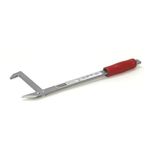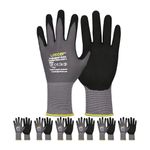Help! Water leaks via electrical service

I wonder if I could ask you all for some help. As you probably heard via the news outlets, we’re having a terrific storm here in the NE. So far, it’s been mainly lots and lots of rain, which has brought back an old friend… a water leak in the basement via the electrical service conduit. Specifically, the water is intruding via the cover over the last sweep the wires make before they enter the main panel (with the meter and all that).
To get into the house, the wires drop from a standard pole via a “U” cover into the first section of conduit (Pole.jpg). Given our history of water intrusion via the electrical service, we tried to permagum the entrance to the first section of conduit.
The first section then runs underground (pole2.jpg) into a transition box in the ground (box.jpg) where the wires do a loop-di-loop before entering the conduit that runs into our house. That second section of conduit was also permagummed. Currently, there is standing water in the box right up to the lower lip of the second section of conduit, so the permagum approach is not working.
The water may or may not be coming in via the first section of conduit… it could be the clay-soil discharging into the box also. With all the rain we’ve had, the soil is 100% saturated. Inside the basement, I pulled about 8 gallons of water out of the basement and a further 10 gallons out of the conduit itself.
Granted, this is a problem that only manifests itself during nasty storms, but I want it to stop. Hence my plea for help, I hope someone else has been able to fix this sort of problem in the past that can help me. I have a couple of ideas and I would appreciate any comments or further ideas for us to consider.
1) Re-permagum the entrance to the first and second sections of conduit. Perhaps we didn’t do it right the first time?
2) Install a dry well into the transition box (sand is between 10-15′ down). We’d probably have to dig it up, turn off power before we drill. Seems like a KISS solution, even if the wife will hate what will do the garden.
3) Install a solar/battery-powered sump pump into the box.
4) Install a little Giant HVAC pump below the last electrical conduit sweep, drill a small hole into the access cover, drain conduit this way.
5) Install water-proof sleeves over the conduit entrance. They look like udders, with one end going over the conduit, the other end having 6 nipples for the wires. We’d have to disconnect power and re-run the wires up the pole but we’d have a water-proof connection.
What do you all think? I appreciate any comments/ideas you may have!
Fine Homebuilding Recommended Products

Bosch Wall Scanner (GMS 120)

Not So Big House

Stabila Classic Level Set

Guardian Fall Protection Pee Vee

MicroFoam Nitrile Coated Work Gloves


















Replies
Well, my first observation is that, if there's standing water in that box, no amount of waterproofing is going to keep the water out of the conduit.
Also, of course, you've got no guarantees that the conduit between the box and the house isn't cracked somewhere.
This is an illustration of why undergound entrance of wiring is unwise. It's far better to have the conduit enter the house above ground.
Thanks, Dan, I appreciate the reponse. Seeing however, that I have no means of moving thr service at this point, I think our option to put a drywell in there is perhaps the best one to prevent water from accumulating in the first place. I am still considering those "udders", BTW. Two 1-3 and then a 2-1 would do the trick and create a water-tight seal. It would not address cracks in the conduit, however.
It depends on the climate. We've had underground power for decades without any problems. Overhead lines are vulnerable to wind and tree damage, and a hazard for working with ladders or lifts.
-- J.S.
I'm not talking about running the lines underground -- that's generally a good idea. I'm talking about having the conduit ENTER the building underground, vs "periscoping" up to enter above ground level.
So convenient a thing it is to be a reasonable Creature, since it enables one to find or make a Reason for everything one has a mind to do. --Benjamin Franklin
Aha -- so you'd have to have a basement to do it wrong. That's why we don't have this problem. Nobody builds with basements here, it's not cost effective.
-- J.S.
So, about 10 tubes of lexel and various bits of XPS (as a spacer between wires) later, we have a sealed conduit entrance, I think. Still a drip or two from the conduit, I hope they are leftovers. Anyway, time will tell. Your periscope idea is a great one, I simply fear the expense...
One possible solution IF it is commong from the box and not around the conduit or through cracked conduit.
Raise the "box". Install a pedistal so that the conduit runs up a foot or two above round. Then you will need to "hide it" with plantings or something.
But I am wondering about a few things.
Where is the meter?
Are you on 3 phase? I see 5 wires and that not usual.
.
A-holes. Hey every group has to have one. And I have been elected to be the one. I should make that my tagline.
Hi Bill,I appreciate the reply. IIRC, there are 6 wires in there, three in, three out (400A service @ 230VAC). As a start, we pulled out the permagum and vacuumed. The conduit to the pole was not the source, it was ground water - the box started filling from the edges as water was being pulled out. The water levels started to drop naturally once the rain stopped indicating some drainage.At this point, I am leaning towards a drywell drain inside the box... straight into the sand that I know is down below. Then we won't have to worry about standing water in there anymore.Raising the conduit is a really good idea, but I wonder a bit on how to implement it. We could disconnect power from the grid, drill the hole and retrofit a riser at the same time. Then fill said riser with Lexol or a similar substance to create a plug of impenetrable goop.For now, I have filled the part of the conduit that is sticking out of the ground with bits of XPS, followed with 5 tubes of Lexol. That stuff ought to stick a lot better to the walls of the conduit and the wires than the permagum. I took great pains to ensure that there is lots of that stuff all around the individual conductors. Since the stuff is sticky and I was dumb enough not to wear gloves, I can't use my fingers very well at this point.As for the meter, it is inside the house, about 3' above the last sweep I described earlier. The electrical service comes into the basement level at about 10" above floor height then turns up and into the meter "box". From there, the meter splits the juice among two panels. The electrical company gets the reading electronically and the historical commission was happy that the house had no overhead electrical service nor exposed meters outside.
> Raising the conduit is a really good idea, but I wonder a bit on how
> to implement it. We could disconnect power from the grid, drill the
> hole and retrofit a riser at the same time. Then fill said riser with
> Lexol or a similar substance to create a plug of impenetrable goop.You could add a riser near the house. It would only have to come up perhaps a foot above the level of the box, do a 180, and go back down to the existing entrance. The section of conduit between the house and the box might fill with water, but it wouldn't get past the loop.George Patterson, Patterson Handyman Service
A wise old man old told me that its a waste of time to try to stop water from flowing down-hill. He also told me that water will flow through cracks. As I was slinking away he shouted after me "...and if there's no cracks now there will be soon!".
Old fart!
Anyway, heed his advice! Expect below-grade conduit to be water-filled 24/7, and arrange for it to drain away. Try to make your drainage "static,", ie, not something that needs a pump, and not something like sand that works until the soil is waterlogged (which is typically just when you need it...).
Brooks
Argh, not looking forward to digging up the electrical service. It can be done, however.A riser coming out of the ground, doing a 180 loop and going back down would do the trick. A small pinhole in the 180 would then act as a vacuum breaker. All in all probably cheaper than trying to get the green box to drain. The only part of the plan I don't like is the prospect of having to splice fat cables, or to replace them altogether. That's 6x 100' of fat Al wiring... Splicing them above ground is likely to require a rather fat containment box, eh?
The thing to do would be to put a box on the outside of the house, remove the existing cable ends from the meter and pull them up into the box. Then use new cable from box to meter.While you're at it you might want to put the meter outside.
So convenient a thing it is to be a reasonable Creature, since it enables one to find or make a Reason for everything one has a mind to do. --Benjamin Franklin
Thanks for the suggestion!I just spoke to the electrician, who could do the work, provided that we shut off power to a number of local houses first (no disconnect between us and the transformer). Yet another way to make ourselves popular with the neighbors! :-PI think the way I want to handle it is to see if the present approach is water-tight or not. If not, we go the whole hog and get the loop out of the ground.